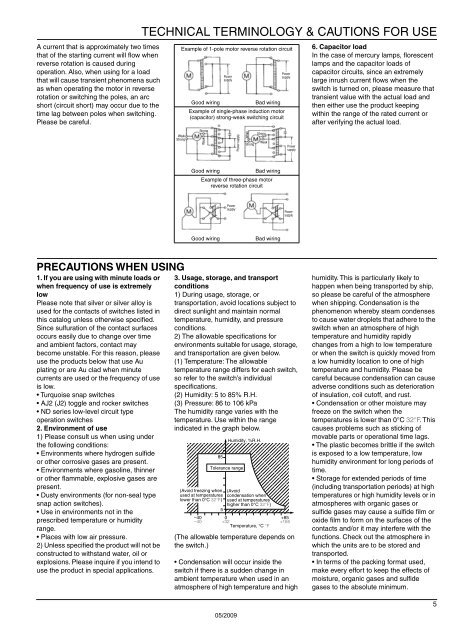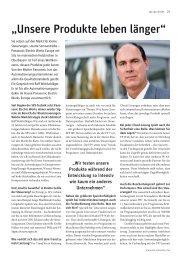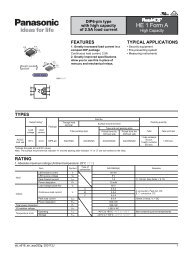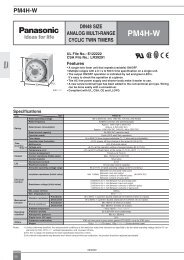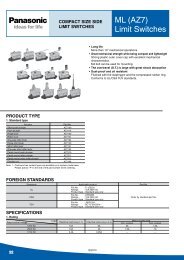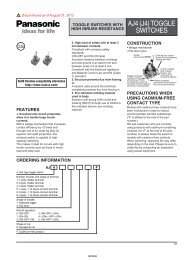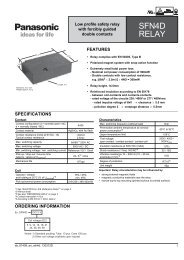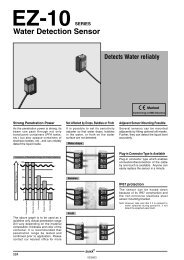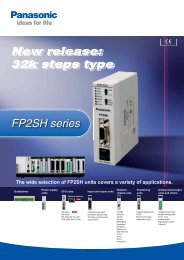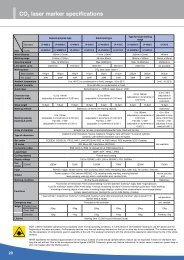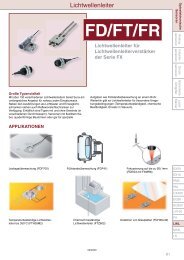T A B L E O F C O N T E N T S - Panasonic Electric Works Europe AG
T A B L E O F C O N T E N T S - Panasonic Electric Works Europe AG
T A B L E O F C O N T E N T S - Panasonic Electric Works Europe AG
Create successful ePaper yourself
Turn your PDF publications into a flip-book with our unique Google optimized e-Paper software.
A current that is approximately two times<br />
that of the starting current will flow when<br />
reverse rotation is caused during<br />
operation. Also, when using for a load<br />
that will cause transient phenomena such<br />
as when operating the motor in reverse<br />
rotation or switching the poles, an arc<br />
short (circuit short) may occur due to the<br />
time lag between poles when switching.<br />
Please be careful.<br />
TECHNICAL TERMINOLOGY & CAUTIONS FOR USE<br />
Weak<br />
Strong<br />
Example of 1-pole motor reverse rotation circuit<br />
Power<br />
supply<br />
Power<br />
supply<br />
Good wiring<br />
Bad wiring<br />
Example of single-phase induction motor<br />
(capacitor) strong-weak switching circuit<br />
Strong<br />
Weak<br />
Power supply<br />
Weak<br />
Strong<br />
Strong<br />
Weak<br />
Power<br />
supply<br />
6. Capacitor load<br />
In the case of mercury lamps, florescent<br />
lamps and the capacitor loads of<br />
capacitor circuits, since an extremely<br />
large inrush current flows when the<br />
switch is turned on, please measure that<br />
transient value with the actual load and<br />
then either use the product keeping<br />
within the range of the rated current or<br />
after verifying the actual load.<br />
Good wiring<br />
Bad wiring<br />
Example of three-phase motor<br />
reverse rotation circuit<br />
Power<br />
supply<br />
Power<br />
supply<br />
Good wiring<br />
Bad wiring<br />
PRECAUTIONS WHEN USING<br />
1. If you are using with minute loads or<br />
when frequency of use is extremely<br />
low<br />
Please note that silver or silver alloy is<br />
used for the contacts of switches listed in<br />
this catalog unless otherwise specified.<br />
Since sulfuration of the contact surfaces<br />
occurs easily due to change over time<br />
and ambient factors, contact may<br />
become unstable. For this reason, please<br />
use the products below that use Au<br />
plating or are Au clad when minute<br />
currents are used or the frequency of use<br />
is low.<br />
• Turquoise snap switches<br />
• AJ2 (J2) toggle and rocker switches<br />
• ND series low-level circuit type<br />
operation switches<br />
2. Environment of use<br />
1) Please consult us when using under<br />
the following conditions:<br />
• Environments where hydrogen sulfide<br />
or other corrosive gases are present.<br />
• Environments where gasoline, thinner<br />
or other flammable, explosive gases are<br />
present.<br />
• Dusty environments (for non-seal type<br />
snap action switches).<br />
• Use in environments not in the<br />
prescribed temperature or humidity<br />
range.<br />
• Places with low air pressure.<br />
2) Unless specified the product will not be<br />
constructed to withstand water, oil or<br />
explosions. Please inquire if you intend to<br />
use the product in special applications.<br />
3. Usage, storage, and transport<br />
conditions<br />
1) During usage, storage, or<br />
transportation, avoid locations subject to<br />
direct sunlight and maintain normal<br />
temperature, humidity, and pressure<br />
conditions.<br />
2) The allowable specifications for<br />
environments suitable for usage, storage,<br />
and transportation are given below.<br />
(1) Temperature: The allowable<br />
temperature range differs for each switch,<br />
so refer to the switch’s individual<br />
specifications.<br />
(2) Humidity: 5 to 85% R.H.<br />
(3) Pressure: 86 to 106 kPa<br />
The humidity range varies with the<br />
temperature. Use within the range<br />
indicated in the graph below.<br />
;<br />
;;;;;<br />
85<br />
Tolerance range<br />
(Avoid freezing when (Avoid<br />
used at temperatures condensation when<br />
lower than 0°C 32°F) used at temperatures<br />
higher than 0°C 32°F)<br />
5<br />
–40<br />
0<br />
–40 +32<br />
Temperature, °C °F<br />
;;;;;;;<br />
;;;;;;;;;;<br />
;;;;;;;;;;;<br />
;;;;;;;;;;;;<br />
;;;;;;;;;;;;<br />
+85<br />
+185<br />
(The allowable temperature depends on<br />
the switch.)<br />
• Condensation will occur inside the<br />
switch if there is a sudden change in<br />
ambient temperature when used in an<br />
atmosphere of high temperature and high<br />
05/2009<br />
Humidity, %R.H.<br />
humidity. This is particularly likely to<br />
happen when being transported by ship,<br />
so please be careful of the atmosphere<br />
when shipping. Condensation is the<br />
phenomenon whereby steam condenses<br />
to cause water droplets that adhere to the<br />
switch when an atmosphere of high<br />
temperature and humidity rapidly<br />
changes from a high to low temperature<br />
or when the switch is quickly moved from<br />
a low humidity location to one of high<br />
temperature and humidity. Please be<br />
careful because condensation can cause<br />
adverse conditions such as deterioration<br />
of insulation, coil cutoff, and rust.<br />
• Condensation or other moisture may<br />
freeze on the switch when the<br />
temperatures is lower than 0°C 32°F. This<br />
causes problems such as sticking of<br />
movable parts or operational time lags.<br />
• The plastic becomes brittle if the switch<br />
is exposed to a low temperature, low<br />
humidity environment for long periods of<br />
time.<br />
• Storage for extended periods of time<br />
(including transportation periods) at high<br />
temperatures or high humidity levels or in<br />
atmospheres with organic gases or<br />
sulfide gases may cause a sulfide film or<br />
oxide film to form on the surfaces of the<br />
contacts and/or it may interfere with the<br />
functions. Check out the atmosphere in<br />
which the units are to be stored and<br />
transported.<br />
• In terms of the packing format used,<br />
make every effort to keep the effects of<br />
moisture, organic gases and sulfide<br />
gases to the absolute minimum.<br />
5


